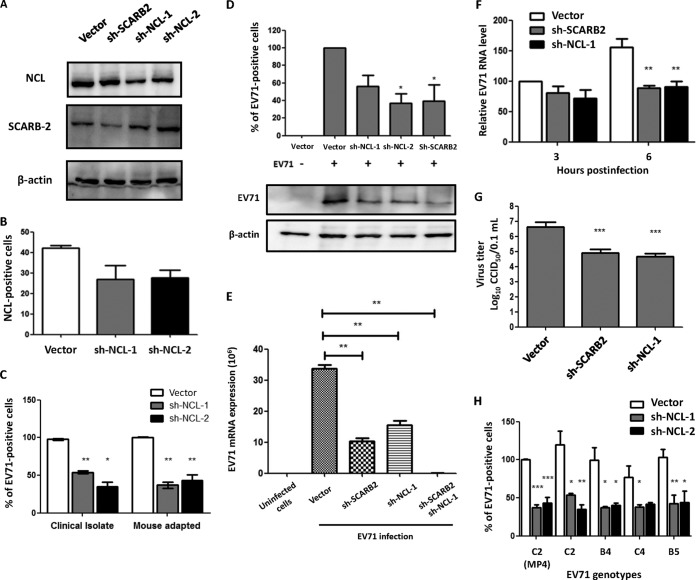FIG 2.
The knockdown of cell surface NCL reduces EV71 binding, infection, and production in RD cells. RD cells were transfected without vector (RD) or with an empty vector (Vector) or the vector containing sh-SCARB2, sh-NCL-1, or sh-NCL-2. The expression levels of SCARB2 and NCL were determined by Western blotting (A) and flow cytometry (B). (C) The binding of an EV71 clinical isolate (87-N6356) or mouse-adapted strain (MP4) to RD cells was determined by flow cytometry. (D) The binding of EV71 (87-N6356) to vector-, sh-NCL-1-, sh-NCL-2-, and sh-SCARB2-transfected RD cells was determined by qRT-PCR (top) and Western blotting (bottom). (E) The binding of EV71 to vector, sh-NCL-1-, sh-SCARB2- and sh-NCL-1–sh-SCARB2-transfected RD cells was determined by qRT-PCR. (F) The relative RNA levels of EV71 (87-N6356) in RD cells at 3 and 6 h p.i. were determined by qRT-PCR. The RNA level of vector cells at 3 h was defined as 100%. (G) The 50% cell culture infective dose (CCID50) values of RD cells infected with EV71 (87-N6356) were evaluated. (H) The binding of different genotypes of EV71 (MP4, C2, B4, C4, and B5 strains) to RD cells was measured by flow cytometry. The mean fluorescence intensity value of MP4-infected vector cells was defined as 100%. The data are representative of the means ± standard deviations (error bars) of ≥3 samples per group. *, P < 0.05; **, P < 0.01; ***, P < 0.001.

